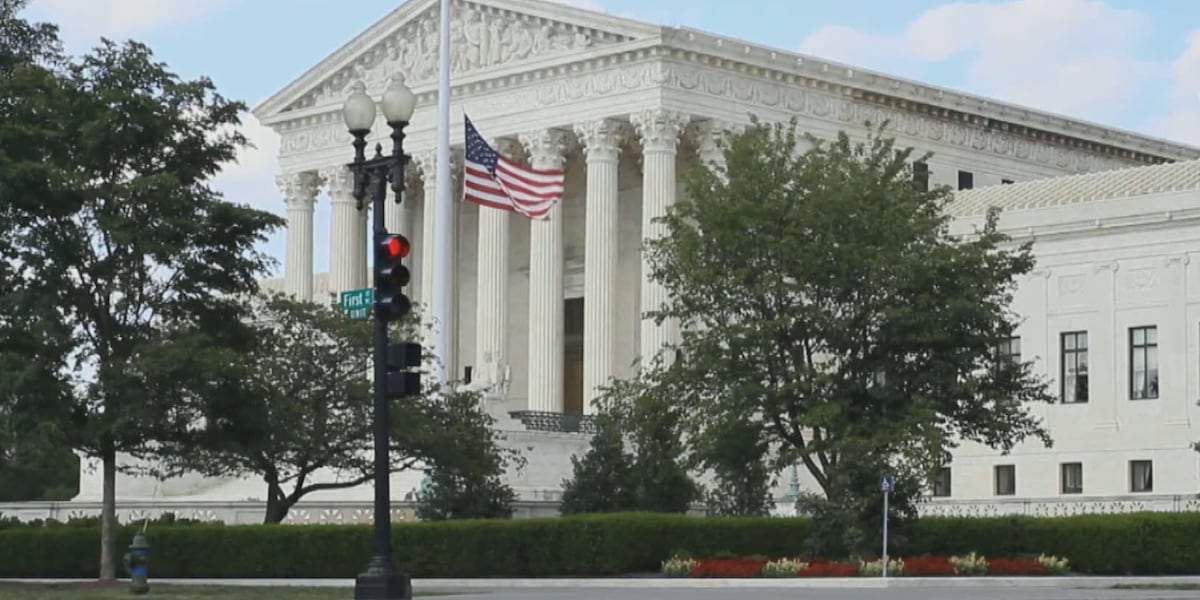Louisiana
La. lawmakers send SB 1 to Gov. Landry

SHREVEPORT, La. (KSLA) — Law-abiding citizens will be able to carry concealed handguns without needing a permit if Louisiana Gov. Jeff Landry signs a bill that’s headed to his desk.
Senate Bill 1 was approved by the Legislature, but not without drawing some opposition, both inside and outside the legislative chambers.
“It increases the risk of fatality when it’s not intended,” one Northwest Louisiana man said.
Another Northwest Louisiana resident said the right to bear arms is a part of his constitutional rights. “It’s the Second Amendment to keep and bear arms to protect ourselves and possessions, our families.”
After passing through both legislative chambers, the no-permit concealed carry law could become the new norm for those who are 18 or older in Louisiana. Landry is expected to sign off on SB 1.
“We’ve always had open carry in Louisiana,” said state Rep. Danny McCormick, R-Oil City. “And this allows people to conceal carry without that government permission. So that’s really important to people to be able to self-protect themselves from criminals.”
State Rep. Tammy Phelps, D-Shreveport, is concerned about more guns being out on the streets.
“We know that those that do not abide by the law are already carrying these weapons without permission. So there was a great concern with putting more guns on the street in that same manner.”
McCormick believes permitless concealed carry will help decrease crime. “In Louisiana, guns are a problem today. Guns aren’t a problem in the hands of law-abiding citizens.”
Without a permit, Phelps asked, how can one determine who’s obeying the law? “You can distinguish a law-abiding citizen as one who has a license and someone who doesn’t. That’s why it’s been this way for so long.”
Copyright 2024 KSLA. All rights reserved.

Louisiana
Legislature gives Landry a win with state money for private schools • Louisiana Illuminator

A proposal to steer state dollars for K-12 public school students to private schools of their choice advanced Thursday from the Louisiana Senate, a week after members forced its author to sideline the measure.
In response, Republican Gov. Jeff Landry starred in a television ad campaign and asked citizens to contact state senators and tell them to vote for the LA GATOR education savings account (ESA) program. The governor was on the Senate chamber sidelines, taking time to talk to multiple lawmakers, before Senate Bill 313 was approved in a 24-15 vote.
“I don’t feel like it’s a big win for me,” Landry told the Illuminator after the vote. “I think it’s a big win for the kids of Louisiana, for parents out there who overwhelmingly, irrespective of party affiliation or economic means, have said in poll after poll after poll that the money should follow the child.”
In addition to the governor’s influence, sizable changes to the proposal’s financial framework were made Thursday. The updated version shifts the task of figuring out how much state funds will be needed for the ESA program from legislators to the state Board of Elementary and Secondary Education (BESE). Once that amount is calculated, it will still be up to lawmakers to decide how much public money to put into the program.
“Let (BESE) do that, you know, then you don’t chip it in stone,” said Sen. Kirk Talbot, R-River Ridge, who authored the amendments approved Thursday. “… I’d rather give BESE the flexibility to determine how much they think that money should be.”
For the time being, there is a question mark over how much education savings accounts will cost the state once they are made available to all students, regardless of household income.
The bill still calls for the program to be launched for the 2025-26 school year, meaning the Legislature would have to determine during next year’s session how much money they want to put into ESA.
The initial participants will be current voucher recipients in the Student Scholarships for Educational Excellence Program in addition to special education students and public school students from families that earn less than 250% of the federal poverty level. Based on federal poverty standards as of March, the qualifying income for a family of four would be under $62,400.
The Educational Excellence Program, enacted in 2008, provides private school tuition vouchers for students from low-income families who attend poor-performing schools. Some 5,500 students received the vouchers in the 2022-23 school year, and the program will lapse once LA GATOR is operating.
In year two of the program, the qualifying family income threshold will be 400% of the poverty level, which is below $124,800 for a family of four.
Education savings accounts would be made available to all families in year three, when the associated cost is projected to soar.
In the bill’s original version, the ESA program would have cost the state $260 million annually once any students could take part, according to the Legislature’s fiscal staff. An independent projection from the Public Affairs Research Council placed the amount closer to $520 million annually.
That uncertain yet sizable sum made some fiscal conservatives, who otherwise support the idea of school choice, wary of voting for the legislation.
“The dollar amount is still a concern,” Talbot said. “That’s our fiduciary responsibility to the state. That never goes away.”
More students could have access to tutoring vouchers, but few have been used so far
Those cost concerns, along with an unwanted school accountability amendment, led the bill’s author, Sen. Rick Edmonds, R-Baton Rouge, to temporarily shelve his measure last week. But Talbot’s changes included removing a stipulation that any student who uses an ESA be administered the same high-stakes testing required of public school students.
Results from the tests would have measured whether schools that accepted ESA students were spending state money effectively, with those falling short not being taken out of the program.
Sen. Katrina Jackson-Andrews, D-Monroe, authored last week’s amendment and objected to its removal Thursday.
“I’ve never understood why someone would be afraid of accountability for a great idea,” Jackson-Andrews said, adding that the lack of testing might signify doubts among ESA supporters in the program’s potential for success.
In place of Jackson-Andrews’ accountability provision, the revised bill allows — but doesn’t require — private schools to test ESA students on math and English. The Louisiana Educational Assessment Program test public school students are required to take includes sections for English, math, science and social studies.
After her week-old amendment was removed, Jackson-Andrews submitted a proposal to align ESA accountability standards with the system in place for current voucher recipients. She excluded any punitive measures for schools whose ESA students perform poorly on assessments.
Edmonds argued that existing standardized tests at private schools will sufficiently measure the progress of ESA students. Jackson-Andrews maintained that private schools shouldn’t be allowed to pick their own assessments, but her amendment was rejected.
A blunted third attempt from Jackson-Andrews to insert accountability measures into the bill was successful. It calls for any assessment standards the state education department adopts to apply to every school in the state, but it doesn’t single out ESA students for separate evaluations.
Although lawmakers won’t make funding decisions on the ESA program until next year, they might help decide where the money might come from sooner. The 144 members of the Legislature and 27 appointees by the governor will take part in a constitutional convention from Aug. 1-15, based on organizing legislation that awaits Senate approval.
Landry and proponents of the event haven’t provided agenda specifics, but removing constitutional protections from certain funding streams is expected to be a priority.
The Minimum Foundation Program (MFP), which provides funding for Louisiana’s K-12 public schools, is one of those protected sources, but Landry has said it wouldn’t be touched during the constitutional rewrite.
The state will provide nearly $4.1 billion to public schools next academic year based on the MFP formula lawmakers are supporting.
Louisiana
Rare high risk of extreme rainfall to trigger 'life-threatening' flooding in Texas and Louisiana

A dangerous, life-threatening flash flooding event is unfolding Thursday as torrential storms pound the already-soaked South.
A rare Level 4 of 4 high risk of excessive rainfall was issued for parts of eastern Texas and western Louisiana by the Weather Prediction Center Thursday. More than 600,000 people live in the high-risk zone.
High risk days only happen on 4% of days each year, but account for more than 80% of all flood damage and more than a third of all flood deaths in the United States, according to the WPC. Just three other days have reached this concerning mark this year, including the most recent one nearly three weeks ago.
It’s a sign the atmosphere is primed to unload extreme amounts of rain, a phenomenon that is becoming more frequent in a warming world driven by human-caused climate change.
Widespread rainfall totals of 2 to 6 inches are expected from Texas to Georgia through Saturday morning. A few spots caught under multiple torrential storms may pick up 8 inches or more of rain. It’s not out of the question that one or two spots could record close to a foot of rain in about 48 hours.
Texas and Louisiana have been in the bull’s-eye of seemingly unrelenting rounds of torrential, flooding downpours since the start of April. Rainfall in the waterlogged area over the last two weeks is over 600% of what’s typical, according to the WPC.
Double-digit rainfall totals between 20 and 30 inches over the region in recent weeks have soaked the ground and left rivers swollen, priming the flood threat to extreme levels.
Drenched soils are not expected to soak up any of Thursday’s rainfall, the WPC warned Thursday morning. Widespread flash flooding could begin minutes after heavy rain starts to fall.
Flooding ramps up Thursday but threat persists Friday
Storms, some severe, rumbled to life Thursday afternoon in parts of Texas and prompted flash flood warnings for multiple cities, including Waco. Powerful, heavy storms will push south and east and reach Louisiana and Mississippi late in the day.
Nearly 10 million people are under a tornado watch until 10 p.m. CT Thursday in portions of southeast Texas and southwest Louisiana, including Houston and Lake Charles, Louisiana.
A large cluster of thunderstorms moving into the region Thursday afternoon brought with it a flash flood threat from the heavy downpours in addition to the severe storm dangers in the strongest cells. A couple of tornadoes could spawn, scattered damaging wind gusts are likely to reach 70 mph and there may be isolated hail up to 2 inches in diameter.
Hundreds of thousands of customers across Texas are without electricity as of Thursday evening, according to PowerOutage.us.
A tornado warning was issued Thursday evening in Harris County, Texas, including downtown Houston, according to the National Weather Service – no tornado has been observed yet, but the storms have the potential to produce one. The weather service also issued a severe thunderstorm warning for Houston with the highest-level “destructive” tag.
At around 6:30 p.m., the weather service in Houston noted a “destructive storm” with wind gusts of up to 80 mph was over the metro area, and urged residents to take cover immediately in a post on X.
Rainfall rates up to 3 inches per hour are possible in the heaviest storms, which could lead to life-threatening flash flooding, according to the WPC. Damaging winds, hail and a couple of tornadoes are also possible.
The greatest flooding danger will come as storms train later Thursday. Training storms track through and deluge the same areas over and over, like a train pulling its cars over the same stretch of track.
Serious flash flooding is likely in any areas caught under multiple storms unloading 2 to 3 inches of rain per hour. Roadways may quickly become rivers and small streams could easily overflow their banks.
More than 35 million people in the South are under a Level 2 of 4 or Level 3 of 4 risk of excessive rainfall Thursday. Many areas may only endure one torrential storm, but even brief downpours will be enough to cause flooding problems given how wet the South has been recently.
Soaking storms will shift east on Friday and target more of the Gulf Coast.
Significant portions of Mississippi and Alabama are under a Level 3 of 4 risk of excessive rainfall on Friday. A larger area from the Texas/Louisiana border to Georgia and the Florida Panhandle is under a Level 2 of 4 risk.
Drenching storms from Thursday night will likely last into Friday morning for parts of the Gulf Coast. An initial round of flash flooding is likely in the first half of Friday before rain starts to taper off in the afternoon.
Another bout of heavy rain will develop Friday night and continue into the earliest hours of Saturday morning, working over the same areas hit earlier in the day. These storms could produce rainfall rates of 2 to 3 inches per hour, and quickly restart or worsen any ongoing flooding.
Extremely wet start to the year
The rain will only add to already extreme rainfall totals in what’s been one of the wettest years to date on record across the Gulf Coast.
Some Southeast cities have recorded more than half a foot of rain above what’s typical for the first several months of the year.
Several dozen cities from Texas to western Georgia are pacing at a top 5 wettest year to date and at least two cities in eastern Texas are experiencing their wettest year, according to the Southeast Regional Climate Center. Dallas is experiencing its third-wettest year to date while Shreveport, Louisiana, is amid its second wettest.
Excessive rainfall has largely eliminated dryness and drought conditions along the Gulf Coast, but it hasn’t come without a cost.
Earlier this month, nearly 2 feet of rain fell in just five days and sent parts of eastern Texas underwater. Hundreds of people and animals were rescued from flooding as some area rivers rose to levels not reached since Hurricane Harvey in 2017.
Copyright 2024 Cable News Network. Turner Broadcasting System, Inc. All Rights Reserved.
Louisiana
Louisiana National Guard send third rotation to Texas border

The following has been provided by the Louisiana National Guard:
NEW ORLEANS – Continuing the request from the State of Texas and with the approval of Louisiana Governor Jeff Landry, the Louisiana National Guard’s 61st Troop Command mobilized 50 Soldiers to the Texas border in support of Operation Lone Star to replace the second rotation that arrived in April. This is the third rotation that the LANG will support, with each lasting approximately 30 days.
“Things are beginning to get warm in Texas as the temperature rises,” said Capt. Zach Neely, commander of LANG’s Task Force Lone Star. “Besides the challenge of the heat, the mission is going smoothly. Communication between Louisiana and Texas is still open and productive.”
The LANG Soldiers are assisting the Texas National Guard with patrols along the southern border to prevent, detect and deter illegal migrant crossings. They have an impact on broader security operations by providing additional manpower and resources to address emerging threats, respond to security incidents and enhance situational awareness along the border region.
Neely expressed that the LANG leadership back home is very supportive.
“They continue to remind me that I have whatever support is needed to ensure mission success and take care of our Soldiers,” said Neely.
“The Soldiers from the 3-156th exceeded all expectations,” said 1st Sgt. Darron Murray, LANG Task Force Lone Star first sergeant. “Their platoon leadership did a good job preparing them for this mission and setting conditions for them to start day one.”
“The last rotation is coming from the 61st TC, and they are eager to support,” said Neely. “They are leaning forward to prepare their Soldiers and be ready to hit the ground running. They will benefit from all the lessons learned from rotations one and two, I’m excited to see how they perform.”
Click here to report a typo. Please provide the title of the article in your email.
Copyright 2024 KALB. All rights reserved.
-

 Politics1 week ago
Politics1 week ago'You need to stop': Gov. Noem lashes out during heated interview over book anecdote about killing dog
-

 Politics1 week ago
Politics1 week agoRFK Jr said a worm ate part of his brain and died in his head
-

 World1 week ago
World1 week agoPentagon chief confirms US pause on weapons shipment to Israel
-

 World1 week ago
World1 week agoConvicted MEP's expense claims must be published: EU court
-

 Politics1 week ago
Politics1 week agoCalifornia Gov Gavin Newsom roasted over video promoting state's ‘record’ tourism: ‘Smoke and mirrors’
-

 News1 week ago
News1 week agoStudents and civil rights groups blast police response to campus protests
-

 Politics1 week ago
Politics1 week agoOhio AG defends letter warning 'woke' masked anti-Israel protesters they face prison time: 'We have a society'
-

 Politics1 week ago
Politics1 week agoBiden’s decision to pull Israel weapons shipment kept quiet until after Holocaust remembrance address: report

















